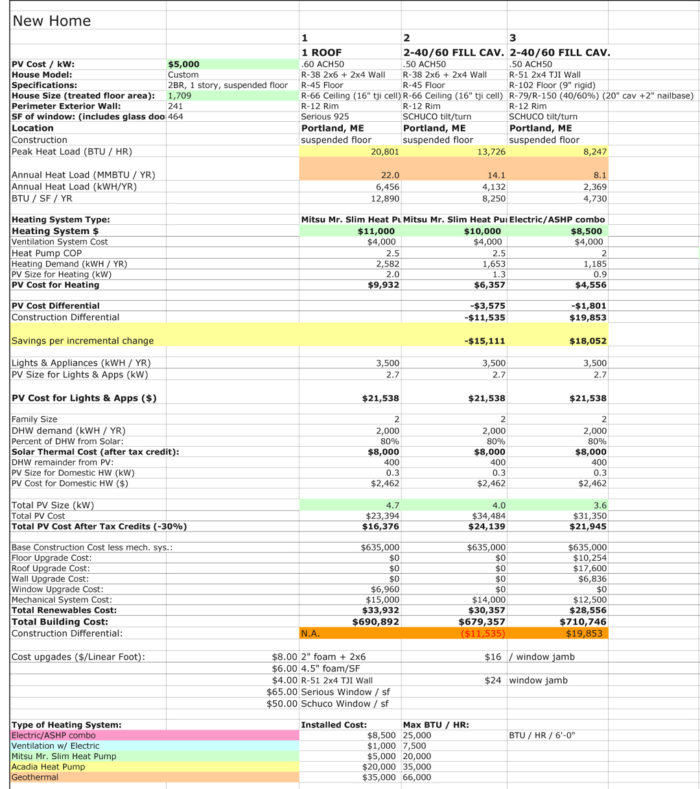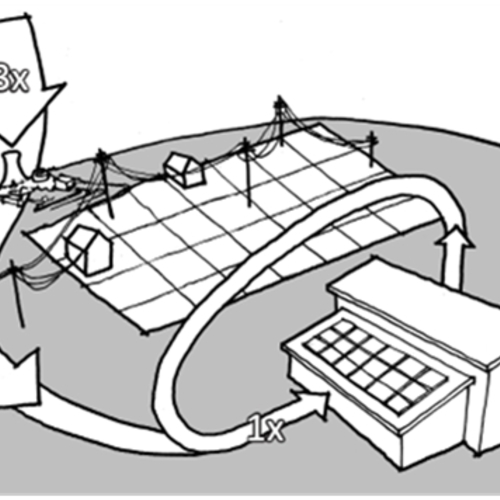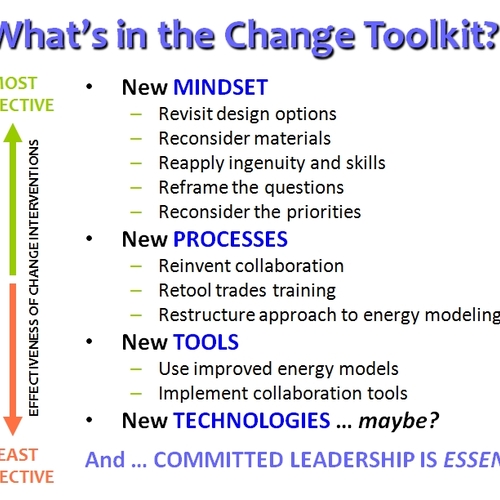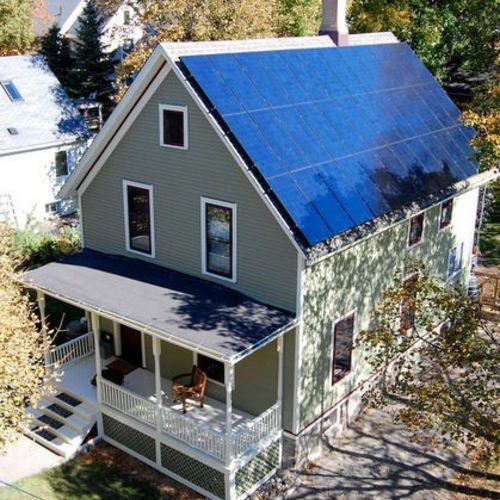In part two of this episode, the Net Zero conversation gets real as Phil and I talk about how to think about the balancing act of increasing your building performance, decreasing your energy demand, decreasing your mechanical costs, and optimizing your cost. Of course you have to have the target of net zero in mind and the whole team has to be on board. We’ve even included a handy spreadsheet that Phil’s office uses to help run the options and find that “sweet spot.”
In Part 2 of this episode, we discuss:
- The client is part of the team. The success of a net-zero home requires commitment from the owner.
- Know the simple strategy and stick to it: Reduce energy demand and make up the difference with renewables.
- Seal it up — bring down that ACH50. Phil chats about using a fog machine as a tool.
- Windows and doors — and daylighting
- Proper insulation — Remember the 10-20-40-60 rule.
- Control solar gain.
- Systems — find the one that’s right for the house.
- Natural ventilation.
- What’s your HERS, before renewables and after renewables? (After renewables, it should be zero).
- Renewables make up the difference — likely solar, because residential wind is difficult.
You can also subscribe to the Green Architects’ Lounge on iTunes. That way, you’ll never miss a show—and it’s free.
Phil and I would love to hear from you. If you have a great idea for an upcoming topic, want to leave general feedback, or want to share your favorite cocktail recipe, you can e-mail us at [email protected]. If you’d like to complain about our tangential ramblings, fragment sentences, or our general irreverence, you can email us at [email protected].
Remember to check back in later for Part 3, where we really get into the details of making net zero cost-effective. We’ll also share some ideas, and Phil shares a great song from the new Bright Eyes album. And of course part one tells you how to make our cocktail of the episode.
Cheers!
TRANSCRIPT
This is Part Two of the net zero series, and we’re going to focus on how to get to zero. We’ve talked about what it is and who’s doing it. We’ve talked about our cocktail, the Irish-American. It has been refreshed and we’re ready to move on.
Chris: Phil, how do we get there? If a client walks in and says, “Hey, I’ve heard about net zero, and I want to be net zero” — what would be your next sentence?
Phil: Right on! Whether you asked me or not, we were headed that way anyway. And it is simple. We know how to do it, but it’s about commitment. We’re doing the things we already know how to do and what you and I have been talking about forever. It’s less about the electrical loads and lighting, and more about reducing our energy demand as much as possible
Chris: Yeah, we’re usually on the big three: air sealing, windows and doors, and insulation. It’s all about buttoning up and reducing your demand. I always like to throw in working with the sun.
Phil: That’s part of it. Here we’re dealing a little bit more with human behavior, but we’re also dealing with our electrical load. Net zero is simple, but a lot of it is up to the person. The best clients are the excited, educated ones — excited about doing something green — and we’re getting more of those.
Chris: Everyone is moving in that direction regardless of whether they want to or not. The goal is to reduce the energy demand as much as possible, and make up the difference with renewables. It’s really that simple. Jamie and I were doing a presentation and he pulled out a great spreadsheet — I have a similar spreadsheet — where you’re playing the “what if” scenario. The envelope is this, and the demand is this; therefore your mechanical system is this. You can almost chart where you start to go overboard with insulation, and you can chart where you can find that sweet spot.
Phil: It’s all about the sweet spot. We can find it in a net-zero optimization spreadsheet. The goal is to make it and put it in a PHPP spreadsheet and make it another tab. All it is, is an Excel spreadsheet.
Chris: It maximizes the optimization of your insulation to the reduction of the mechanical system so that the cost for your mechanical system is low and the cost for your insulation and other features is not that high. That’s the sweet spot.
Phil: And the n the numbers will show you need $160,000 worth of renewables to get to net zero. Then you’ll bring it up to a R-40 wall and R-60 ceiling, and your renewables will come down to $40,000. Here’s the cool thing. I’ve had this conversation with Martin Holladay — at some point you should just buy more PVs and make it easier on yourself.
Chris: Usually that conversation happens when you’re at the Passivhaus level. And you have the Passivhaus versus net zero discussion.
Phil: Let’s go through the list. To reduce the energy demand, let’s get airtight. There’s the “big three,” and number one is “airtight.”
Chris: That’s a wave of construction quality that is important. People know ACH50 now. If I say “ACH50” in a group of peers, 25% of them know it.
Phil: Here’s a cool thing. We’ve only done it with one house, but I see people advocating for it: fog machines. You want to see a builder get on board quick: fill the house with fog, and send him on the outside of his house where he can see where his house is leaking. It’s kind of a commercial trick. The fog machine showed us the usual culprits around the doors that weren’t well sealed yet.
Chris: You’re doing the opposite of the blower door. With the blower door you’re depressurizing the house and measuring how quickly it re-pressurizes. You get digital numbers at the door. With a fog machine you’re getting a fog machine on the inside and filling the place with fog, pressurizing the house and seeing where it leaks out. You stand at the outside of the house and you go, “Holy cow.”
Phil: Airtightness. Windows and doors. We can say a little more about net zero. We can talk about optimized glazing.
Chris: You’re trying to optimize day lighting so you’re minimizing the electrical usage of your lights. With net zero, every watt counts.
Phil: We add daylighting to the list. It’s not just optimizing your glazing. It’s also daylighting. It’s kind of different, but it’s a corollary. Moving on to proper insulation.
Chris: If you’re doing net zero, you’re at least doing 10/20/40/60 — the recommendations from the Building Science Corporation guys. Real quick: R-20 at the basement walls, R-40 for regular walls, and R-60 for whatever is above, and R-10 for under the slab. It’s not standard, but it’s a good rule of thumb.
Phil: We find that people are often curious how we came up with that. When we do our cost-optimization spreadsheets, we generally end up in that area. R-40 keeps popping up — it’s kind of a sweet spot. Control of solar gains is more important to net zero south of us. They worry about overheating; you basically want to stick a big umbrella over the house in the summer.
Chris: Clever architects figure out a way to do cool shading, and get rid of it in the winter and bring it back in the summer. Deciduous trees are great. I don’t know if we talked about this in our windows podcast, but you must balance your desire to see out your windows. With your systems you’ve reduced your demand and you’re trying to find the system that is your perfect match.
Phil: That’s when we had our conversation about heat-pump COP: coefficient of performance. You have a high COP, then you could do a heat-pump scenario. We keep talking about getting off of fossil fuels. Heat-pumps are a great way to do that. They’re taking the mechanical world by storm. There’s a great article in the latest issue of Fine Homebuilding about how to heat a low-energy home. It’s a Martin article.
Chris: Are we at the point when we talk about renewables?
Phil: The last thing I want to mention is natural ventilation. We talked about how different it is down South. Maximize comfort and minimize the need for mechanical equipment. AC is important, but if you can catch those prevailing winds, you may not need it as much. Know your site and have rooms that have access to that air. In the South, AC is necessary some of the time, and in the North we have to heat our houses. It’s not within the human comfort zone
Chris: Let’s talk real quick about HERS. It is the energy score from the Energy Star system. It’s a home energy rating system, and the closest thing we have to mpg for houses. In our climate zone, zone 6, if you get a HERS Index of 80, congratulations — you get an Energy Star label. You are 20% better than the code-compliant house. If I’ve got a HERS 40, you’re in striking distance of starting to use renewables and getting to net zero, with options of PV or wind. We’ve yet to do a podcast on wind, because residential wind is hard. You’ll likely only qualify for wind if your climate is too windy and brutal to be outside. Wind guys, e-mail me and tell me where I am wrong, and we’ll do a podcast on it.
Phil: If you’re going to do renewables, you’re probably doing PV. If you want to get your heat or AC low, start considering solar hot water, biomass, geothermal. Those things all help out, but they’re not really helping your electricity load.
Chris: Biomass can be carbon-neutral but not net zero. All right, let’s call this Part Two and we’ll wrap it up.
Weekly Newsletter
Get building science and energy efficiency advice, plus special offers, in your inbox.
















9 Comments
I'll head off kitten comments...
You see, Jesse has recently been fond of expressing himself with kitten posters. At first, it's a little weird but soon, after you get your third or fourth poster from him, the funny starts to creep in. He goes to Ihazcheezburger dot com, selects the kitten image types the message, and presto instant kitten poster! So the image we included in the blog is a salute to him. There. I've spent to much time on it already.
Cheers.
Chris Briley, Architect
construction costing
I appreciate the snapshot of the spreadsheet.
Could you expand on how you determine your construction costs?
Attaining accurate estimates for renewables and mech systems I find to be readily available but when working on custom homes costing the project has been more of an 'adventure' than a straight forward exercise.
Do you do construction costing in-house? Hire an estimator? Or do you have a trustworthy GC that provides the costing for free?
Are you costing just the shell? Or does the entire construction cost including finishes typically get wrapped up into your numbers?
Your spreadsheet represents a new generation of professional responsibility. The folks I work with and I are comfortable with the energy modeling aspect and are trying to get a better handle on the optimal cost scenarios. Thanks for sharing some of your experience.
It's all good
Chris your blogs are always good and "Helpful"
I especially liked this one.
edited to delete kitten poster
Spreadsheet 2.0
J & anyone else who is paying attention,
A revised version of the Net-Zero cost optimization spreadsheet (much improved!) has been uploaded. This new version shows clearer direct comparisons between cost of electricity from your local utility & PV, along with a section to iteratively change construction & energy costs costs and see the effects on the overall project.
It's much better than the previous version, but still a work in progress.
If you pay more than $0.15 / kWH from your utility, the costs are really close these days, it's very surprising to see just how affordable PV electricity can be right now when rolled into a mortgage.
Jesse Thompson
Kaplan Thompson Architects
http://www.kaplanthompson.com
A revised version of the
Spreadsheet Here.
Or you can
Spreadsheet Here.
Or you can go back up to the intro to the blog and where it mentions the spreadsheet. The word "spreadsheet" is colored green indicating that it is a link.
Enjoy.
Chris
Thanks for the spreadsheet
I'm having a glance over it right now.
Phil, Jesse and Company
I was reading one of my computer hardware forum sites this evening and I stumbled across an interesting piece, written by a personal computer gamer from the great state of Texas. I thought, given the discussion in your podcast in relation to home occupants and appliances etc, that you may enjoy a read of it.
Here is a short quote from his piece.
The full piece is available here:
http://semiaccurate.com/forums/showthread.php?t=4886
Thanks
Thanks for the information and the levity - are you sure you guys are architects??? I'm starting up a new house project next week in MA - the client is dedicated to Net Zero. I'm excited to get into the details, had to start with GBA of course. :-)
Log in or create an account to post a comment.
Sign up Log in